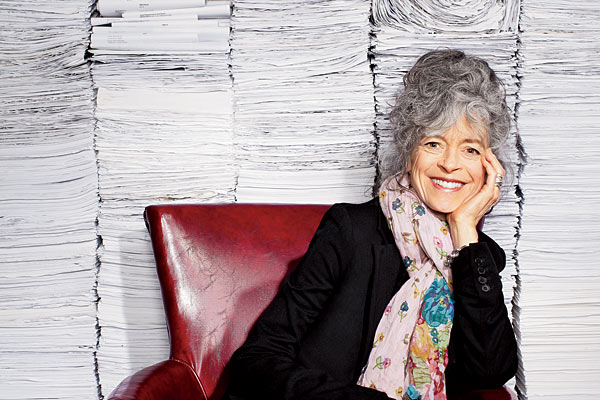Interview by Cassie Walker Burke

Photo: (Lavey) Lisa Predko; Hair and Makeup: Karen Brody; Photographer’s Assistants: Lyndon French and Brian Gladkowski; Installation: Linsey Burritt and Crystal Grover/theindoprojects.com
Lavey with 20 years’ worth of scripts at the Steppenwolf Garage
What drove Steppenwolf’s recent decision to expand its North Side footprint: creativity or finances?
It was an artistic impulse. We are bursting at the seams with all of the programming we have, and not just with 16 plays a season on our [three] stages. We have so many under-the-radar programs: new play development and readings; our Steppenwolf for Young Adults series; our professional training program for actors—which we have to house offsite. There is just no more room at the inn.
In the early days, Steppenwolf performers were described as brilliant, volatile, and as “subtle as 400 Ex-Lax.” Are you still?
Most of the ensemble members [including Joan Allen, John Malkovich, and Gary Sinise] now live in other places, so the emotion—well, I tend to get it one on one over the phone. But we carved our identity out of adventurous work. If we do something too conventional, I hear from people. People don’t go to Steppenwolf naive that they are going to be solaced or find something overly familiar.
Are enough good new plays being written?
There is a constant influx. It is thrilling. For the 2013–14 season [which begins in September], we are doing an American premiere, two Midwest premieres, and two world premieres.
Do you have a script-reading ritual?
I read plays on the elliptical machine in the morning at the gym. And I read them at night before I go to sleep.
How did it feel to read Tracy Letts’s script for August: Osage County [which premiered at Steppenwolf in 2007 and later won a Pulitzer]?
It was like, Bam! People have sometimes said, “Wow, it’s really great that you knew to put that play on.” But there wasn’t any question.
Is it hard to lure some of the far-flung ensemble members back to Chicago to perform?
Yes, of course. But it’s not just them. Nonfamous people have competing interests and lives. This is why Tracy Letts calls the Steppenwolf ensemble “the ongoing experiment.” It’s one thing to be a tight ensemble when you are 20 years old. When you’re older, it’s harder. But I don’t care. A friend of mine said one time that the test of a real friend is that you love even his or her messes. I like the form of messes that we generate as an ensemble.
How did you get Joan Allen, who last performed here in 1991, back for this fall?
We recently had invited Joanie to read a couple of plays. We did one in New York, where she lives, with some other ensemble members. Then we read another two weeks later in Chicago, and she flew in and did that. It got her juices flowing. She was really moved by how instantly the ensemble feeling comes back.
How do you react when people say that Chicago is a farm team for New York theatre, a place where risks happen but not necessarily financial rewards?
I don’t have any sort of resentment toward it. This is a sophisticated theatre town. Not just with the artists, but with the audience too. In Chicago, there is a big appetite for what we do, but also for what the Goodman does, and TimeLine and Lookingglass. You can see a wonderful heterodox mix of stuff.
What could the city do to help take Chicago’s theatre scene to the next level?
The Chicago Cultural Plan says that we need to wear Chicago theatre as a bigger badge in how the city presents itself nationally and internationally. I would like to see that. But I also wish we had a hotel tax, a stream of income dedicated to supplementing this sector. It would help everybody.
Do all theatres need help or just the small storefront ones?
All of them. Remember that some of the flagship theatres here do work that is mindful of the whole ecosystem of Chicago theatre: mentoring, providing space, training people who end up running small theatres or working at them. There is a lot of programming that costs money; it doesn’t earn it.
How involved is your board, which includes Groupon CEO Eric Lefkofsky?
No one ever says, “We don’t want you to do that play.” There are concerns about the size of the season; the biggest expense of any theatre company is how many people are paid per week to do a show. We are really lucky because the board is signed on to the idea that the distinguishing characteristic of this theatre is that it is artist driven. There is an ensemble of 43 artists. We are here to serve them.
Even though you’ve been Steppenwolf’s artistic director for nearly 20 years, you still typically take a role each season. Why?
Acting forces me to interrupt my rhythm, the timing of my day, where I sit in the room. [As artistic director], I’m constantly the person sitting at the head of the table; [as an actor], I’m just another person sitting at a table. Every play is a new thing.
RELATED: Here Are Steppenwolf’s Four Most Exciting New Plays »


